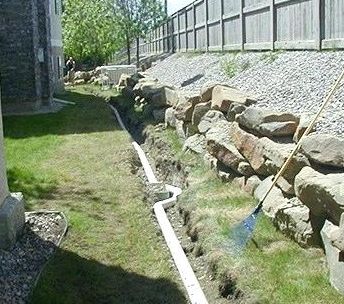Can you prevent flooding caused by excessive rainfall?
Here’s a great question from one of our customers…
“With all of the rainfall we’ve had in Maryland over the last year, we’ve had more than our share of flooding, primarily due to the fact that the ground slopes towards the house, not away from it.”

“What’s the best way to get the ground to slope away from our home to stop ground level flooding, in a minimal space, in a way the ground won’t erode away in one or two years?”
“Are there any technologies or products out there… any companies that can help?”
So yep… this is a pretty common problem, especially where homes are built in close proximity to each other.
And the one of the primary reasons flooding happens is simple physics… Water always flows downhill, via the easiest route possible. So if the grade slopes towards your home instead of away from it, you’ll have a problem area where water can accumulate.
So how can you change the slope or grade around your home so it won’t flood after heavy rains?
And nope…to increase the grade, you simply can’t pile up dirt against the house because it’s usually against building codes, plus could bring termites into play.
We did our own research and talked to a pro, and what we found out is this…
There is no simple, inexpensive, one-solution-fits-all answer to this problem.
Each situation has completely different environmental and landscaping variables that must be taken into account.
So one of the most common solutions we found to prevent flooding is to install French drains either outside your home, in your basement, or even in both places.
A French drain is basically nothing more than a ditch or trench with a perforated pipe in it that carries water away from your home and deposits it in another location further away on your property. (You need to be careful where it goes, too, because you don’t want to give your water flooding woes to your neighbor – it’s often against the law).

And the other most effective solution is to actually change the grade of the land so it slopes away from your home.
But this is isn’t cheap, and makes a complete mess of your property.
No matter which solution is used, it will involve digging and excavation – the extent will be determined by which solution you use and the lay of your land.
And if you dig, make sure you call in a company such as Dig Safe to check for underground utilities!
Don’t forget gutters and downspouts
There is another way to help reduce flooding when it rains…
It
doesn’t take into effect the slope or grade of your land, and isn’t a
“permanent” solution, but it will at least significantly reduce the amount of water that goes into the ground at your
foundation.
A professionally designed gutter system, and correctly placed downspouts!
Think about this…
For every inch of rain, about 1,500-1,600 gallons of water will run off an average size 3,000 sq foot roof with every one inch of rain!
That’s a lot of water falling next to your foundation without gutters.
Gutters and downspouts placed to funnel the water away from your home and foundation will certainly help reduce, if not eliminate flooding.
And gutters are much less expensive than excavating and digging up your entire yard. (Though that may still be necessary)
To get more detailed information about French drains or land grading, contact a local foundation, basement, or landscape contractor. And if you have any questions about how gutters can help, or would like a no-obligation analysis of your gutter situation, please give us a call.
Whether your home is in Frederick, or Silver Spring, over to Columbia, Maryland, or any community in between, we can help!
So if you have any questions about this topic or how we can help, call Kim at 301-368-3551
On Top Home Improvements, Inc.
10818 Avonlea Ridge Place
Damascus, MD 20872
Tel: 301-368-3551
Click to E-mail


1 Comment.
Nice article! Ironic that the picture you used is exactly what I’ve come up with, only option really. Like you said, you can’t just pile up soil on the house without not going against (in our case) the 6″ code, but you’d be inviting termites! So I have no choice but did ‘down’ as far away from the house as possible to get my slope. That’s actually the easy part. The hard part is making sure that your trench is then sloped in the direction you need or want the water to run. And all at the same time making sure that you’re not draining it right into the neighbors yard (like ours is to us).